Evaluating Equality and Diversity's Impact on Sainsbury's Performance
VerifiedAdded on 2023/01/13
|32
|6258
|1
Report
AI Summary
This business research project investigates the impact of equality and diversity on employee productivity and organizational performance at Sainsbury's. The report begins with an introduction, outlining the aim, objectives, research questions, and a literature review on the importance of equality and diversity management. The methodology section details the research type (qualitative), data collection methods (questionnaires), data analysis techniques (thematic), and sampling strategy. The core of the report presents the data analysis, including the questionnaire results from 10 employees, and interprets the findings, highlighting the positive perception of Sainsbury's commitment to equality and diversity. The report also includes sections on cost, quality control, resources, risk factors, and an ethical considerations, along with a reflection and conclusion that offers recommendations for future research and improvements. References and appendices, including the research proposal and ethics approval forms, are also included to provide comprehensive documentation of the study.
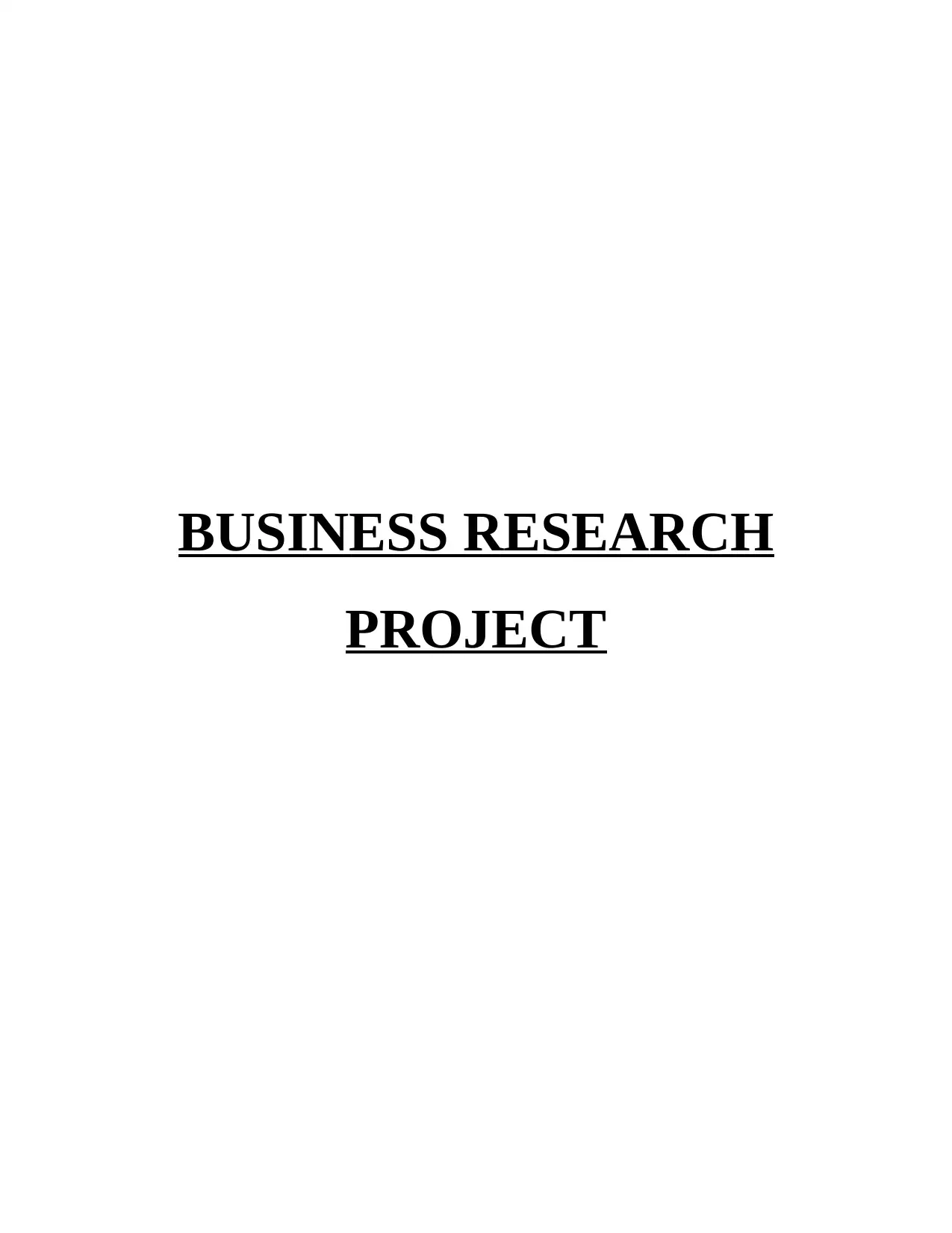
BUSINESS RESEARCH
PROJECT
PROJECT
Paraphrase This Document
Need a fresh take? Get an instant paraphrase of this document with our AI Paraphraser
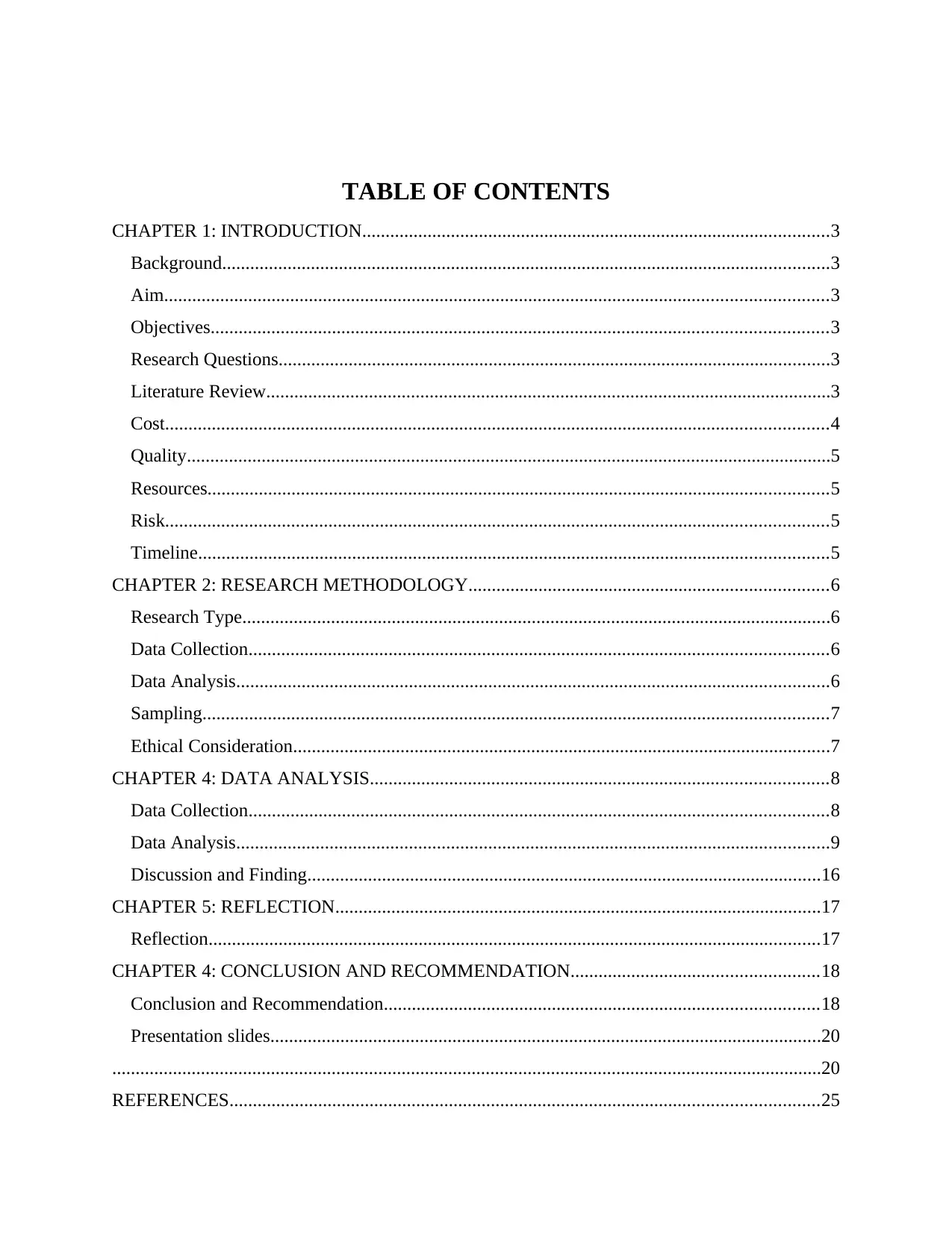
TABLE OF CONTENTS
CHAPTER 1: INTRODUCTION....................................................................................................3
Background..................................................................................................................................3
Aim..............................................................................................................................................3
Objectives....................................................................................................................................3
Research Questions......................................................................................................................3
Literature Review.........................................................................................................................3
Cost..............................................................................................................................................4
Quality..........................................................................................................................................5
Resources.....................................................................................................................................5
Risk..............................................................................................................................................5
Timeline.......................................................................................................................................5
CHAPTER 2: RESEARCH METHODOLOGY.............................................................................6
Research Type..............................................................................................................................6
Data Collection............................................................................................................................6
Data Analysis...............................................................................................................................6
Sampling......................................................................................................................................7
Ethical Consideration...................................................................................................................7
CHAPTER 4: DATA ANALYSIS..................................................................................................8
Data Collection............................................................................................................................8
Data Analysis...............................................................................................................................9
Discussion and Finding..............................................................................................................16
CHAPTER 5: REFLECTION........................................................................................................17
Reflection...................................................................................................................................17
CHAPTER 4: CONCLUSION AND RECOMMENDATION.....................................................18
Conclusion and Recommendation.............................................................................................18
Presentation slides......................................................................................................................20
........................................................................................................................................................20
REFERENCES..............................................................................................................................25
CHAPTER 1: INTRODUCTION....................................................................................................3
Background..................................................................................................................................3
Aim..............................................................................................................................................3
Objectives....................................................................................................................................3
Research Questions......................................................................................................................3
Literature Review.........................................................................................................................3
Cost..............................................................................................................................................4
Quality..........................................................................................................................................5
Resources.....................................................................................................................................5
Risk..............................................................................................................................................5
Timeline.......................................................................................................................................5
CHAPTER 2: RESEARCH METHODOLOGY.............................................................................6
Research Type..............................................................................................................................6
Data Collection............................................................................................................................6
Data Analysis...............................................................................................................................6
Sampling......................................................................................................................................7
Ethical Consideration...................................................................................................................7
CHAPTER 4: DATA ANALYSIS..................................................................................................8
Data Collection............................................................................................................................8
Data Analysis...............................................................................................................................9
Discussion and Finding..............................................................................................................16
CHAPTER 5: REFLECTION........................................................................................................17
Reflection...................................................................................................................................17
CHAPTER 4: CONCLUSION AND RECOMMENDATION.....................................................18
Conclusion and Recommendation.............................................................................................18
Presentation slides......................................................................................................................20
........................................................................................................................................................20
REFERENCES..............................................................................................................................25

Appendix........................................................................................................................................26
Research Proposal Form............................................................................................................26
Research Ethics Approval Form................................................................................................27
Research Proposal Form............................................................................................................26
Research Ethics Approval Form................................................................................................27
⊘ This is a preview!⊘
Do you want full access?
Subscribe today to unlock all pages.

Trusted by 1+ million students worldwide
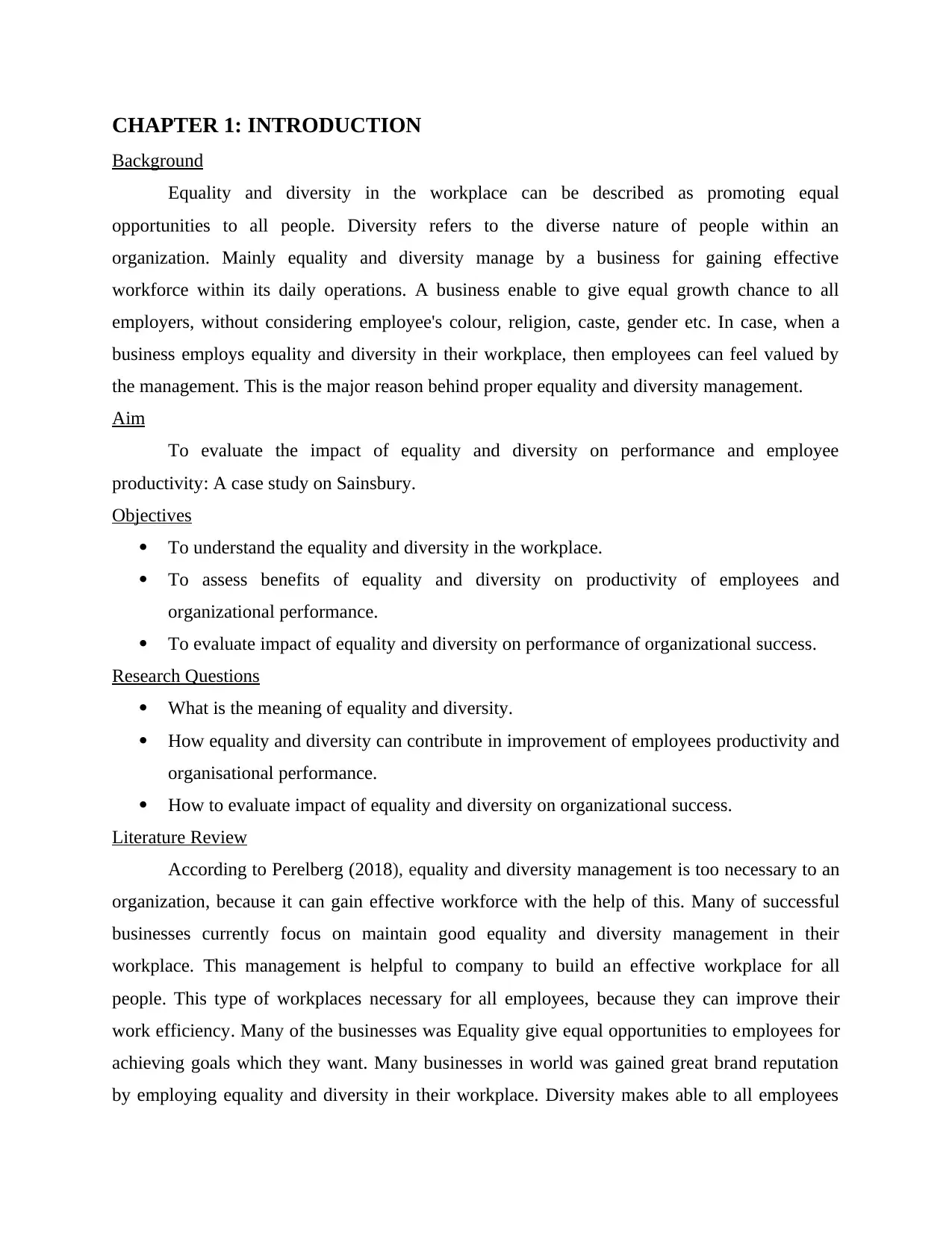
CHAPTER 1: INTRODUCTION
Background
Equality and diversity in the workplace can be described as promoting equal
opportunities to all people. Diversity refers to the diverse nature of people within an
organization. Mainly equality and diversity manage by a business for gaining effective
workforce within its daily operations. A business enable to give equal growth chance to all
employers, without considering employee's colour, religion, caste, gender etc. In case, when a
business employs equality and diversity in their workplace, then employees can feel valued by
the management. This is the major reason behind proper equality and diversity management.
Aim
To evaluate the impact of equality and diversity on performance and employee
productivity: A case study on Sainsbury.
Objectives
To understand the equality and diversity in the workplace.
To assess benefits of equality and diversity on productivity of employees and
organizational performance.
To evaluate impact of equality and diversity on performance of organizational success.
Research Questions
What is the meaning of equality and diversity.
How equality and diversity can contribute in improvement of employees productivity and
organisational performance.
How to evaluate impact of equality and diversity on organizational success.
Literature Review
According to Perelberg (2018), equality and diversity management is too necessary to an
organization, because it can gain effective workforce with the help of this. Many of successful
businesses currently focus on maintain good equality and diversity management in their
workplace. This management is helpful to company to build an effective workplace for all
people. This type of workplaces necessary for all employees, because they can improve their
work efficiency. Many of the businesses was Equality give equal opportunities to employees for
achieving goals which they want. Many businesses in world was gained great brand reputation
by employing equality and diversity in their workplace. Diversity makes able to all employees
Background
Equality and diversity in the workplace can be described as promoting equal
opportunities to all people. Diversity refers to the diverse nature of people within an
organization. Mainly equality and diversity manage by a business for gaining effective
workforce within its daily operations. A business enable to give equal growth chance to all
employers, without considering employee's colour, religion, caste, gender etc. In case, when a
business employs equality and diversity in their workplace, then employees can feel valued by
the management. This is the major reason behind proper equality and diversity management.
Aim
To evaluate the impact of equality and diversity on performance and employee
productivity: A case study on Sainsbury.
Objectives
To understand the equality and diversity in the workplace.
To assess benefits of equality and diversity on productivity of employees and
organizational performance.
To evaluate impact of equality and diversity on performance of organizational success.
Research Questions
What is the meaning of equality and diversity.
How equality and diversity can contribute in improvement of employees productivity and
organisational performance.
How to evaluate impact of equality and diversity on organizational success.
Literature Review
According to Perelberg (2018), equality and diversity management is too necessary to an
organization, because it can gain effective workforce with the help of this. Many of successful
businesses currently focus on maintain good equality and diversity management in their
workplace. This management is helpful to company to build an effective workplace for all
people. This type of workplaces necessary for all employees, because they can improve their
work efficiency. Many of the businesses was Equality give equal opportunities to employees for
achieving goals which they want. Many businesses in world was gained great brand reputation
by employing equality and diversity in their workplace. Diversity makes able to all employees
Paraphrase This Document
Need a fresh take? Get an instant paraphrase of this document with our AI Paraphraser
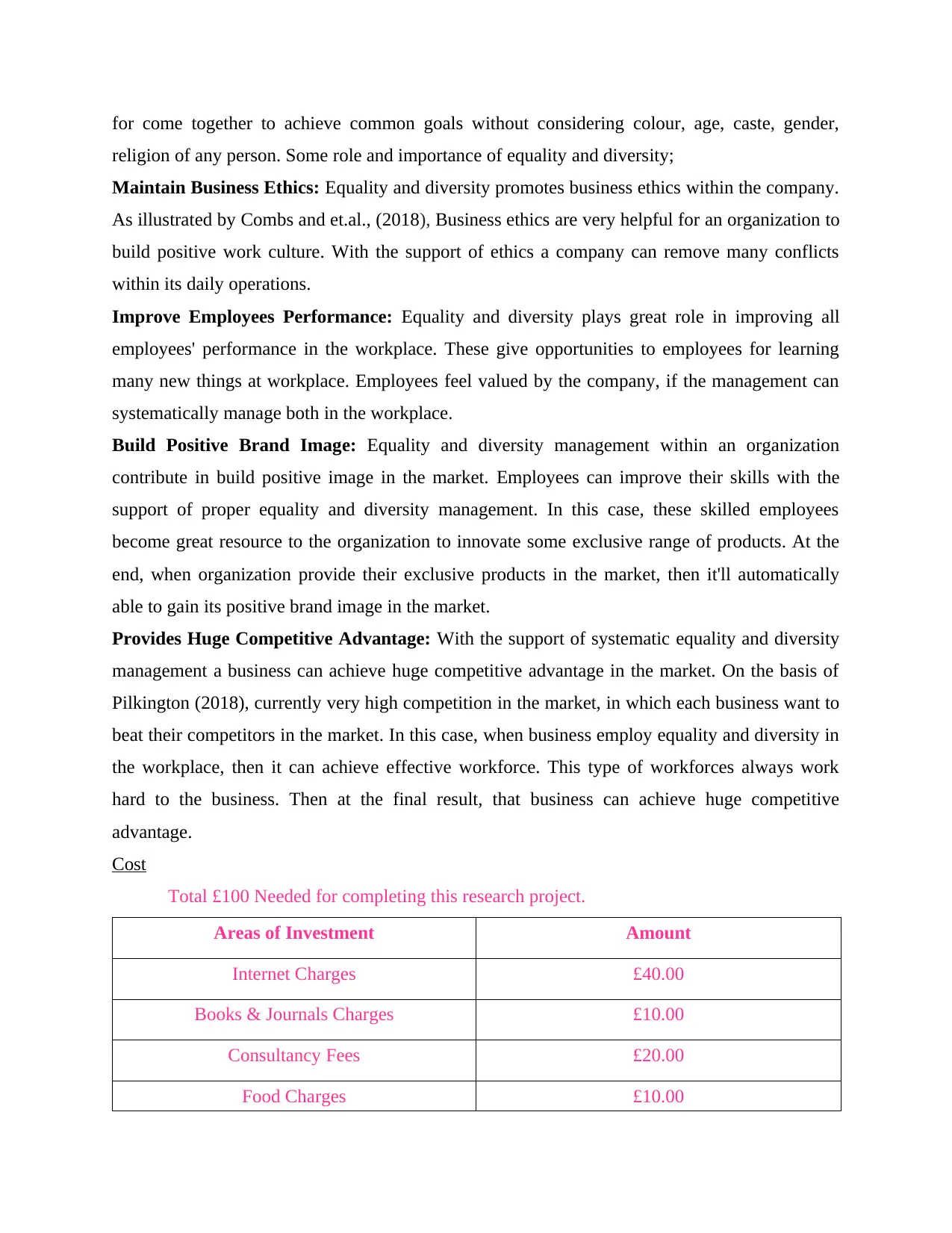
for come together to achieve common goals without considering colour, age, caste, gender,
religion of any person. Some role and importance of equality and diversity;
Maintain Business Ethics: Equality and diversity promotes business ethics within the company.
As illustrated by Combs and et.al., (2018), Business ethics are very helpful for an organization to
build positive work culture. With the support of ethics a company can remove many conflicts
within its daily operations.
Improve Employees Performance: Equality and diversity plays great role in improving all
employees' performance in the workplace. These give opportunities to employees for learning
many new things at workplace. Employees feel valued by the company, if the management can
systematically manage both in the workplace.
Build Positive Brand Image: Equality and diversity management within an organization
contribute in build positive image in the market. Employees can improve their skills with the
support of proper equality and diversity management. In this case, these skilled employees
become great resource to the organization to innovate some exclusive range of products. At the
end, when organization provide their exclusive products in the market, then it'll automatically
able to gain its positive brand image in the market.
Provides Huge Competitive Advantage: With the support of systematic equality and diversity
management a business can achieve huge competitive advantage in the market. On the basis of
Pilkington (2018), currently very high competition in the market, in which each business want to
beat their competitors in the market. In this case, when business employ equality and diversity in
the workplace, then it can achieve effective workforce. This type of workforces always work
hard to the business. Then at the final result, that business can achieve huge competitive
advantage.
Cost
Total £100 Needed for completing this research project.
Areas of Investment Amount
Internet Charges £40.00
Books & Journals Charges £10.00
Consultancy Fees £20.00
Food Charges £10.00
religion of any person. Some role and importance of equality and diversity;
Maintain Business Ethics: Equality and diversity promotes business ethics within the company.
As illustrated by Combs and et.al., (2018), Business ethics are very helpful for an organization to
build positive work culture. With the support of ethics a company can remove many conflicts
within its daily operations.
Improve Employees Performance: Equality and diversity plays great role in improving all
employees' performance in the workplace. These give opportunities to employees for learning
many new things at workplace. Employees feel valued by the company, if the management can
systematically manage both in the workplace.
Build Positive Brand Image: Equality and diversity management within an organization
contribute in build positive image in the market. Employees can improve their skills with the
support of proper equality and diversity management. In this case, these skilled employees
become great resource to the organization to innovate some exclusive range of products. At the
end, when organization provide their exclusive products in the market, then it'll automatically
able to gain its positive brand image in the market.
Provides Huge Competitive Advantage: With the support of systematic equality and diversity
management a business can achieve huge competitive advantage in the market. On the basis of
Pilkington (2018), currently very high competition in the market, in which each business want to
beat their competitors in the market. In this case, when business employ equality and diversity in
the workplace, then it can achieve effective workforce. This type of workforces always work
hard to the business. Then at the final result, that business can achieve huge competitive
advantage.
Cost
Total £100 Needed for completing this research project.
Areas of Investment Amount
Internet Charges £40.00
Books & Journals Charges £10.00
Consultancy Fees £20.00
Food Charges £10.00
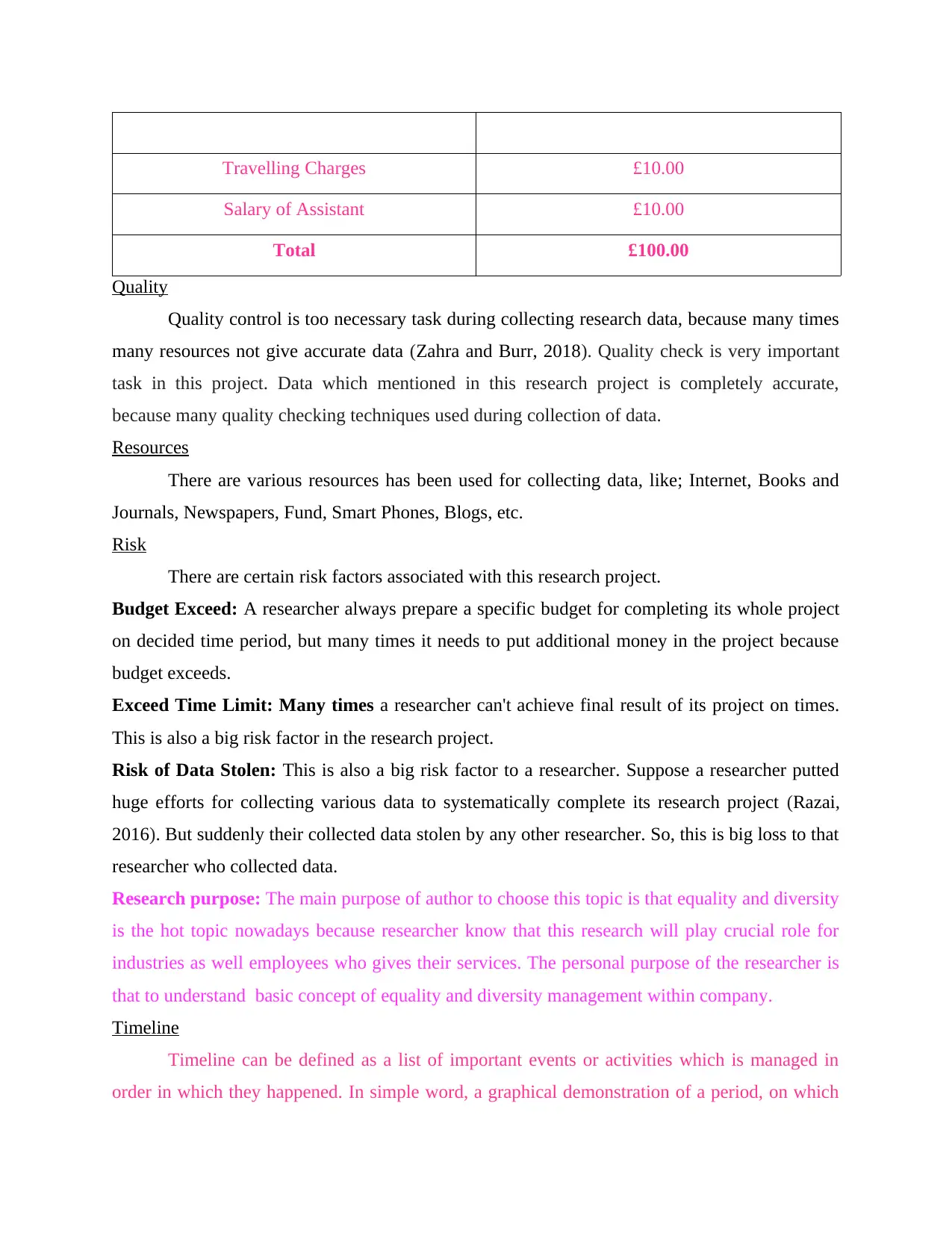
Travelling Charges £10.00
Salary of Assistant £10.00
Total £100.00
Quality
Quality control is too necessary task during collecting research data, because many times
many resources not give accurate data (Zahra and Burr, 2018). Quality check is very important
task in this project. Data which mentioned in this research project is completely accurate,
because many quality checking techniques used during collection of data.
Resources
There are various resources has been used for collecting data, like; Internet, Books and
Journals, Newspapers, Fund, Smart Phones, Blogs, etc.
Risk
There are certain risk factors associated with this research project.
Budget Exceed: A researcher always prepare a specific budget for completing its whole project
on decided time period, but many times it needs to put additional money in the project because
budget exceeds.
Exceed Time Limit: Many times a researcher can't achieve final result of its project on times.
This is also a big risk factor in the research project.
Risk of Data Stolen: This is also a big risk factor to a researcher. Suppose a researcher putted
huge efforts for collecting various data to systematically complete its research project (Razai,
2016). But suddenly their collected data stolen by any other researcher. So, this is big loss to that
researcher who collected data.
Research purpose: The main purpose of author to choose this topic is that equality and diversity
is the hot topic nowadays because researcher know that this research will play crucial role for
industries as well employees who gives their services. The personal purpose of the researcher is
that to understand basic concept of equality and diversity management within company.
Timeline
Timeline can be defined as a list of important events or activities which is managed in
order in which they happened. In simple word, a graphical demonstration of a period, on which
Salary of Assistant £10.00
Total £100.00
Quality
Quality control is too necessary task during collecting research data, because many times
many resources not give accurate data (Zahra and Burr, 2018). Quality check is very important
task in this project. Data which mentioned in this research project is completely accurate,
because many quality checking techniques used during collection of data.
Resources
There are various resources has been used for collecting data, like; Internet, Books and
Journals, Newspapers, Fund, Smart Phones, Blogs, etc.
Risk
There are certain risk factors associated with this research project.
Budget Exceed: A researcher always prepare a specific budget for completing its whole project
on decided time period, but many times it needs to put additional money in the project because
budget exceeds.
Exceed Time Limit: Many times a researcher can't achieve final result of its project on times.
This is also a big risk factor in the research project.
Risk of Data Stolen: This is also a big risk factor to a researcher. Suppose a researcher putted
huge efforts for collecting various data to systematically complete its research project (Razai,
2016). But suddenly their collected data stolen by any other researcher. So, this is big loss to that
researcher who collected data.
Research purpose: The main purpose of author to choose this topic is that equality and diversity
is the hot topic nowadays because researcher know that this research will play crucial role for
industries as well employees who gives their services. The personal purpose of the researcher is
that to understand basic concept of equality and diversity management within company.
Timeline
Timeline can be defined as a list of important events or activities which is managed in
order in which they happened. In simple word, a graphical demonstration of a period, on which
⊘ This is a preview!⊘
Do you want full access?
Subscribe today to unlock all pages.

Trusted by 1+ million students worldwide
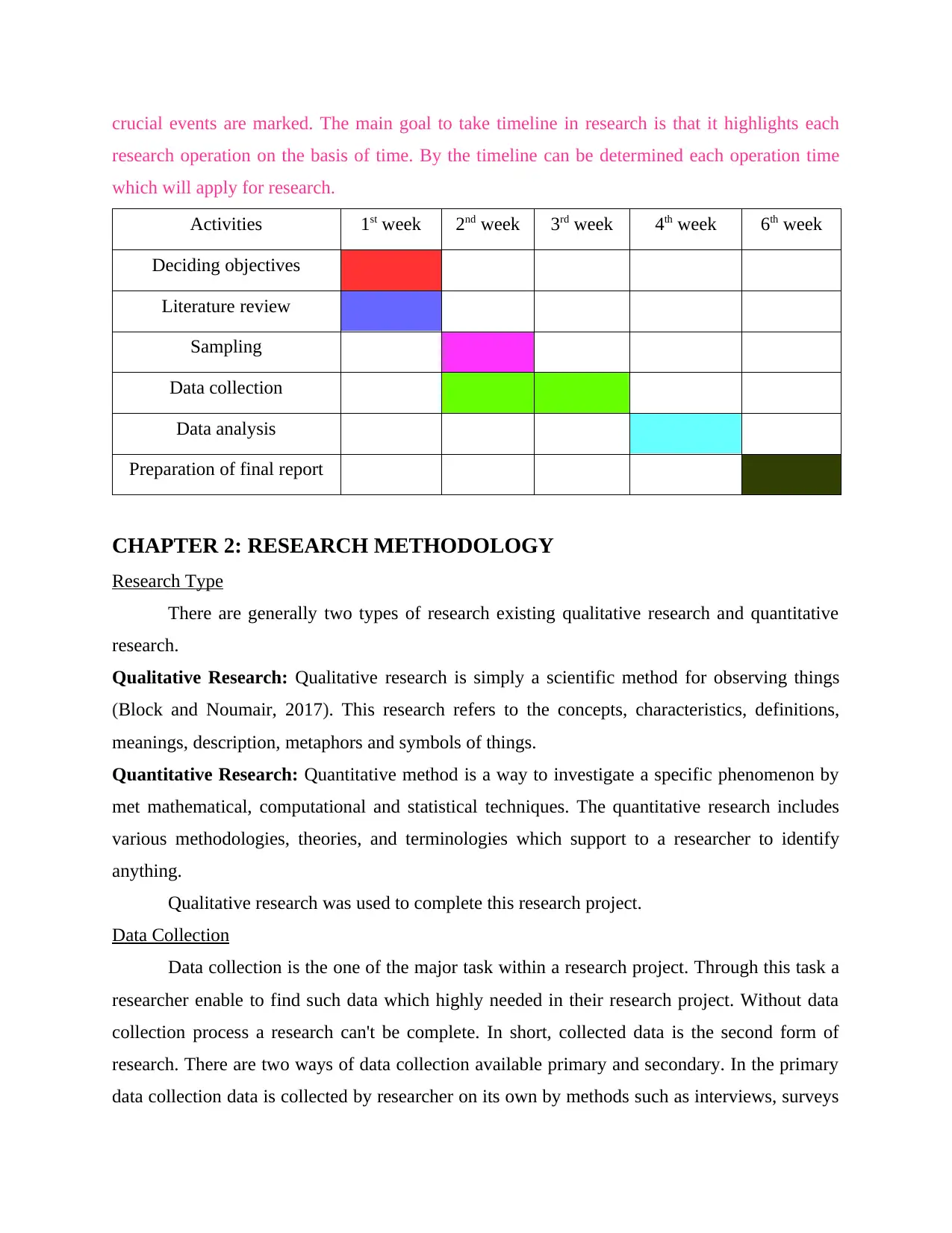
crucial events are marked. The main goal to take timeline in research is that it highlights each
research operation on the basis of time. By the timeline can be determined each operation time
which will apply for research.
Activities 1st week 2nd week 3rd week 4th week 6th week
Deciding objectives
Literature review
Sampling
Data collection
Data analysis
Preparation of final report
CHAPTER 2: RESEARCH METHODOLOGY
Research Type
There are generally two types of research existing qualitative research and quantitative
research.
Qualitative Research: Qualitative research is simply a scientific method for observing things
(Block and Noumair, 2017). This research refers to the concepts, characteristics, definitions,
meanings, description, metaphors and symbols of things.
Quantitative Research: Quantitative method is a way to investigate a specific phenomenon by
met mathematical, computational and statistical techniques. The quantitative research includes
various methodologies, theories, and terminologies which support to a researcher to identify
anything.
Qualitative research was used to complete this research project.
Data Collection
Data collection is the one of the major task within a research project. Through this task a
researcher enable to find such data which highly needed in their research project. Without data
collection process a research can't be complete. In short, collected data is the second form of
research. There are two ways of data collection available primary and secondary. In the primary
data collection data is collected by researcher on its own by methods such as interviews, surveys
research operation on the basis of time. By the timeline can be determined each operation time
which will apply for research.
Activities 1st week 2nd week 3rd week 4th week 6th week
Deciding objectives
Literature review
Sampling
Data collection
Data analysis
Preparation of final report
CHAPTER 2: RESEARCH METHODOLOGY
Research Type
There are generally two types of research existing qualitative research and quantitative
research.
Qualitative Research: Qualitative research is simply a scientific method for observing things
(Block and Noumair, 2017). This research refers to the concepts, characteristics, definitions,
meanings, description, metaphors and symbols of things.
Quantitative Research: Quantitative method is a way to investigate a specific phenomenon by
met mathematical, computational and statistical techniques. The quantitative research includes
various methodologies, theories, and terminologies which support to a researcher to identify
anything.
Qualitative research was used to complete this research project.
Data Collection
Data collection is the one of the major task within a research project. Through this task a
researcher enable to find such data which highly needed in their research project. Without data
collection process a research can't be complete. In short, collected data is the second form of
research. There are two ways of data collection available primary and secondary. In the primary
data collection data is collected by researcher on its own by methods such as interviews, surveys
Paraphrase This Document
Need a fresh take? Get an instant paraphrase of this document with our AI Paraphraser
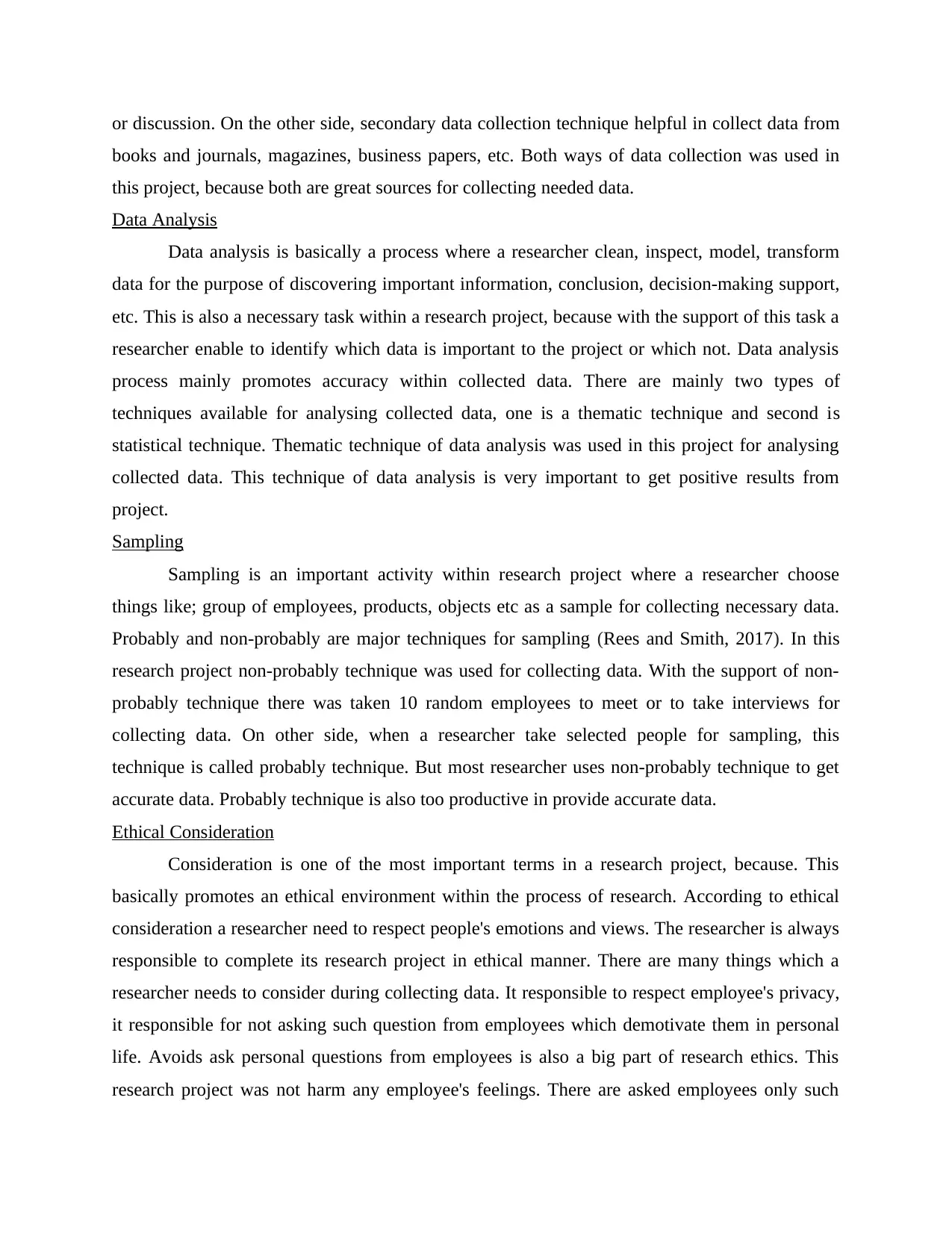
or discussion. On the other side, secondary data collection technique helpful in collect data from
books and journals, magazines, business papers, etc. Both ways of data collection was used in
this project, because both are great sources for collecting needed data.
Data Analysis
Data analysis is basically a process where a researcher clean, inspect, model, transform
data for the purpose of discovering important information, conclusion, decision-making support,
etc. This is also a necessary task within a research project, because with the support of this task a
researcher enable to identify which data is important to the project or which not. Data analysis
process mainly promotes accuracy within collected data. There are mainly two types of
techniques available for analysing collected data, one is a thematic technique and second is
statistical technique. Thematic technique of data analysis was used in this project for analysing
collected data. This technique of data analysis is very important to get positive results from
project.
Sampling
Sampling is an important activity within research project where a researcher choose
things like; group of employees, products, objects etc as a sample for collecting necessary data.
Probably and non-probably are major techniques for sampling (Rees and Smith, 2017). In this
research project non-probably technique was used for collecting data. With the support of non-
probably technique there was taken 10 random employees to meet or to take interviews for
collecting data. On other side, when a researcher take selected people for sampling, this
technique is called probably technique. But most researcher uses non-probably technique to get
accurate data. Probably technique is also too productive in provide accurate data.
Ethical Consideration
Consideration is one of the most important terms in a research project, because. This
basically promotes an ethical environment within the process of research. According to ethical
consideration a researcher need to respect people's emotions and views. The researcher is always
responsible to complete its research project in ethical manner. There are many things which a
researcher needs to consider during collecting data. It responsible to respect employee's privacy,
it responsible for not asking such question from employees which demotivate them in personal
life. Avoids ask personal questions from employees is also a big part of research ethics. This
research project was not harm any employee's feelings. There are asked employees only such
books and journals, magazines, business papers, etc. Both ways of data collection was used in
this project, because both are great sources for collecting needed data.
Data Analysis
Data analysis is basically a process where a researcher clean, inspect, model, transform
data for the purpose of discovering important information, conclusion, decision-making support,
etc. This is also a necessary task within a research project, because with the support of this task a
researcher enable to identify which data is important to the project or which not. Data analysis
process mainly promotes accuracy within collected data. There are mainly two types of
techniques available for analysing collected data, one is a thematic technique and second is
statistical technique. Thematic technique of data analysis was used in this project for analysing
collected data. This technique of data analysis is very important to get positive results from
project.
Sampling
Sampling is an important activity within research project where a researcher choose
things like; group of employees, products, objects etc as a sample for collecting necessary data.
Probably and non-probably are major techniques for sampling (Rees and Smith, 2017). In this
research project non-probably technique was used for collecting data. With the support of non-
probably technique there was taken 10 random employees to meet or to take interviews for
collecting data. On other side, when a researcher take selected people for sampling, this
technique is called probably technique. But most researcher uses non-probably technique to get
accurate data. Probably technique is also too productive in provide accurate data.
Ethical Consideration
Consideration is one of the most important terms in a research project, because. This
basically promotes an ethical environment within the process of research. According to ethical
consideration a researcher need to respect people's emotions and views. The researcher is always
responsible to complete its research project in ethical manner. There are many things which a
researcher needs to consider during collecting data. It responsible to respect employee's privacy,
it responsible for not asking such question from employees which demotivate them in personal
life. Avoids ask personal questions from employees is also a big part of research ethics. This
research project was not harm any employee's feelings. There are asked employees only such
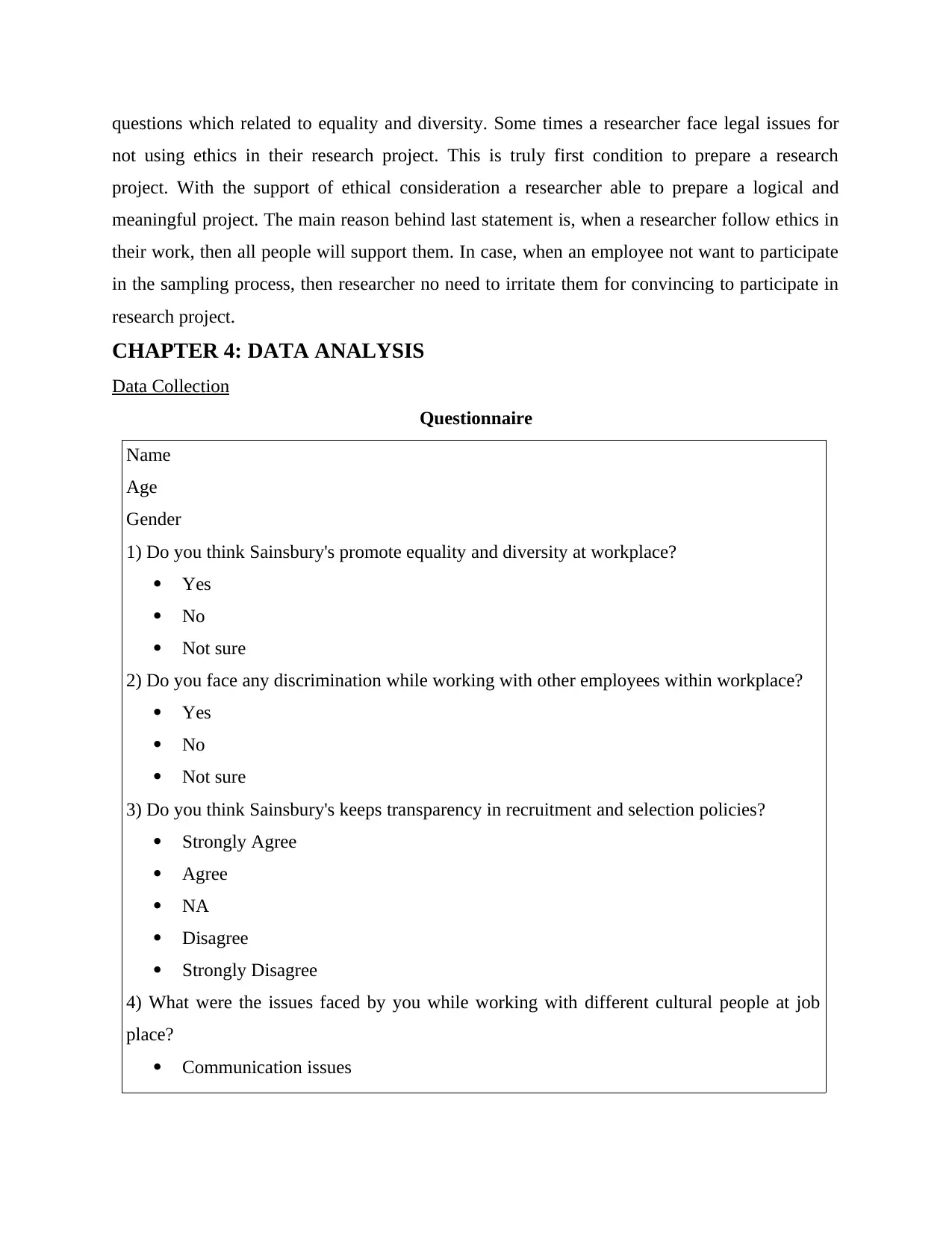
questions which related to equality and diversity. Some times a researcher face legal issues for
not using ethics in their research project. This is truly first condition to prepare a research
project. With the support of ethical consideration a researcher able to prepare a logical and
meaningful project. The main reason behind last statement is, when a researcher follow ethics in
their work, then all people will support them. In case, when an employee not want to participate
in the sampling process, then researcher no need to irritate them for convincing to participate in
research project.
CHAPTER 4: DATA ANALYSIS
Data Collection
Questionnaire
Name
Age
Gender
1) Do you think Sainsbury's promote equality and diversity at workplace?
Yes
No
Not sure
2) Do you face any discrimination while working with other employees within workplace?
Yes
No
Not sure
3) Do you think Sainsbury's keeps transparency in recruitment and selection policies?
Strongly Agree
Agree
NA
Disagree
Strongly Disagree
4) What were the issues faced by you while working with different cultural people at job
place?
Communication issues
not using ethics in their research project. This is truly first condition to prepare a research
project. With the support of ethical consideration a researcher able to prepare a logical and
meaningful project. The main reason behind last statement is, when a researcher follow ethics in
their work, then all people will support them. In case, when an employee not want to participate
in the sampling process, then researcher no need to irritate them for convincing to participate in
research project.
CHAPTER 4: DATA ANALYSIS
Data Collection
Questionnaire
Name
Age
Gender
1) Do you think Sainsbury's promote equality and diversity at workplace?
Yes
No
Not sure
2) Do you face any discrimination while working with other employees within workplace?
Yes
No
Not sure
3) Do you think Sainsbury's keeps transparency in recruitment and selection policies?
Strongly Agree
Agree
NA
Disagree
Strongly Disagree
4) What were the issues faced by you while working with different cultural people at job
place?
Communication issues
⊘ This is a preview!⊘
Do you want full access?
Subscribe today to unlock all pages.

Trusted by 1+ million students worldwide
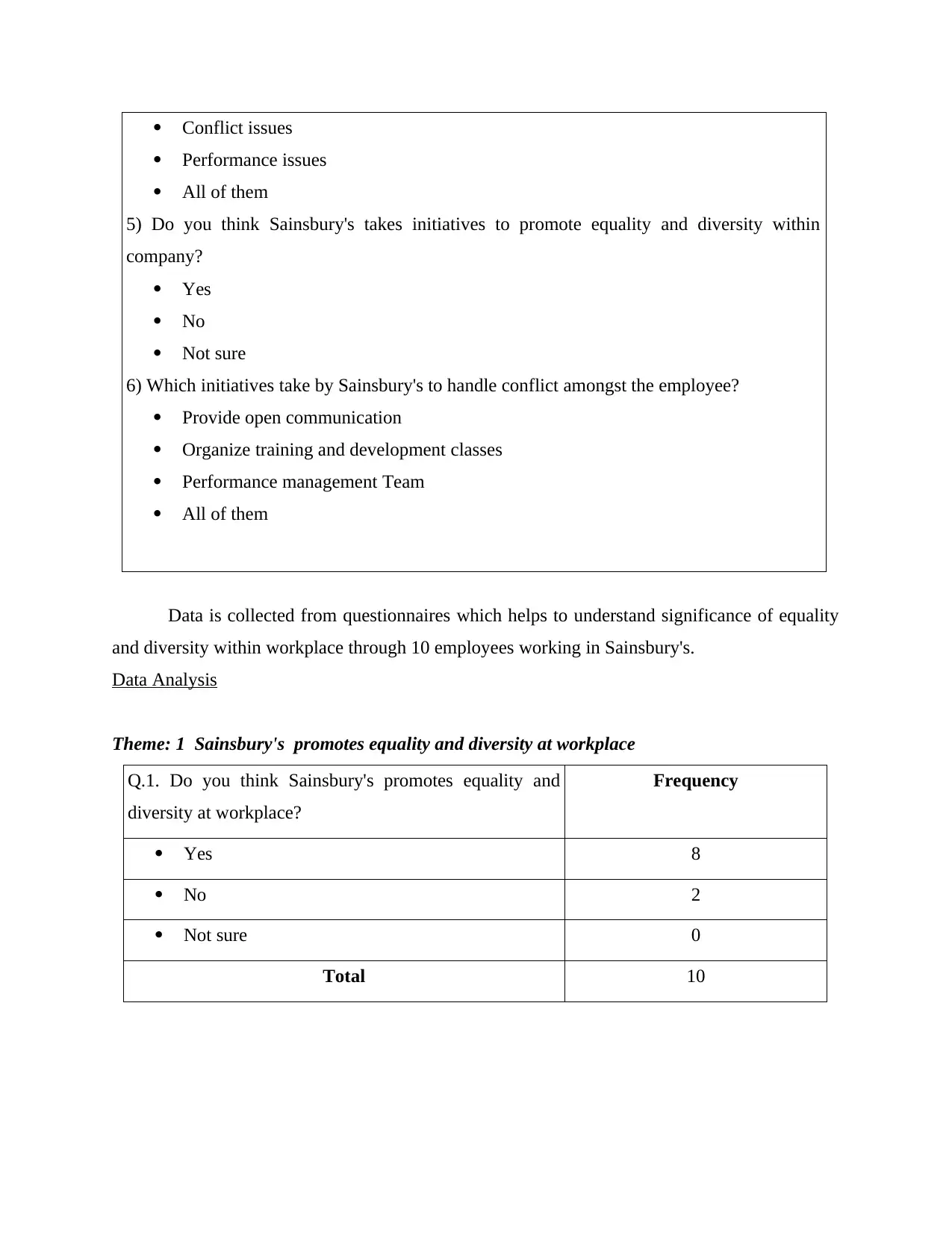
Conflict issues
Performance issues
All of them
5) Do you think Sainsbury's takes initiatives to promote equality and diversity within
company?
Yes
No
Not sure
6) Which initiatives take by Sainsbury's to handle conflict amongst the employee?
Provide open communication
Organize training and development classes
Performance management Team
All of them
Data is collected from questionnaires which helps to understand significance of equality
and diversity within workplace through 10 employees working in Sainsbury's.
Data Analysis
Theme: 1 Sainsbury's promotes equality and diversity at workplace
Q.1. Do you think Sainsbury's promotes equality and
diversity at workplace?
Frequency
Yes 8
No 2
Not sure 0
Total 10
Performance issues
All of them
5) Do you think Sainsbury's takes initiatives to promote equality and diversity within
company?
Yes
No
Not sure
6) Which initiatives take by Sainsbury's to handle conflict amongst the employee?
Provide open communication
Organize training and development classes
Performance management Team
All of them
Data is collected from questionnaires which helps to understand significance of equality
and diversity within workplace through 10 employees working in Sainsbury's.
Data Analysis
Theme: 1 Sainsbury's promotes equality and diversity at workplace
Q.1. Do you think Sainsbury's promotes equality and
diversity at workplace?
Frequency
Yes 8
No 2
Not sure 0
Total 10
Paraphrase This Document
Need a fresh take? Get an instant paraphrase of this document with our AI Paraphraser
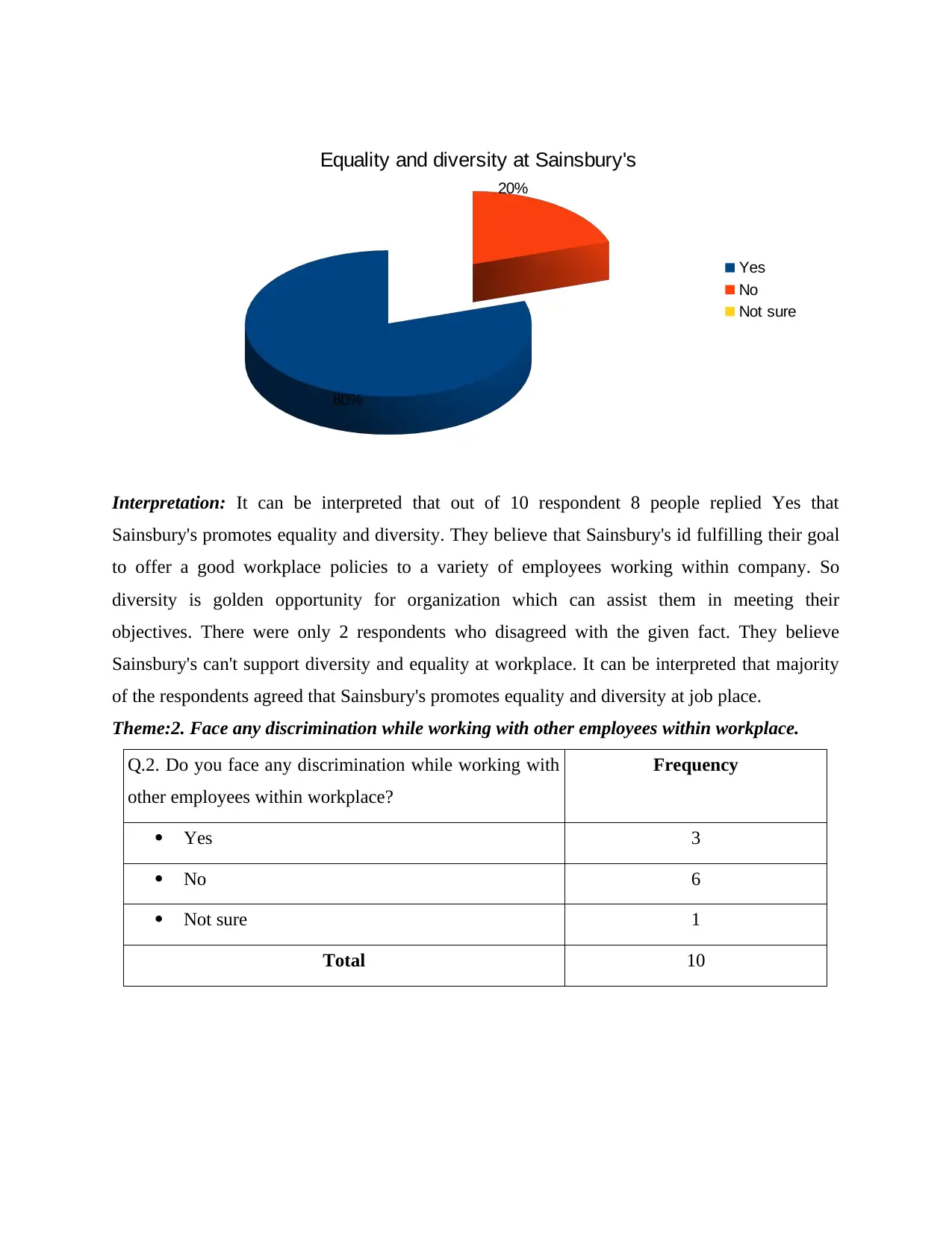
Interpretation: It can be interpreted that out of 10 respondent 8 people replied Yes that
Sainsbury's promotes equality and diversity. They believe that Sainsbury's id fulfilling their goal
to offer a good workplace policies to a variety of employees working within company. So
diversity is golden opportunity for organization which can assist them in meeting their
objectives. There were only 2 respondents who disagreed with the given fact. They believe
Sainsbury's can't support diversity and equality at workplace. It can be interpreted that majority
of the respondents agreed that Sainsbury's promotes equality and diversity at job place.
Theme:2. Face any discrimination while working with other employees within workplace.
Q.2. Do you face any discrimination while working with
other employees within workplace?
Frequency
Yes 3
No 6
Not sure 1
Total 10
80%
20%
Equality and diversity at Sainsbury's
Yes
No
Not sure
Sainsbury's promotes equality and diversity. They believe that Sainsbury's id fulfilling their goal
to offer a good workplace policies to a variety of employees working within company. So
diversity is golden opportunity for organization which can assist them in meeting their
objectives. There were only 2 respondents who disagreed with the given fact. They believe
Sainsbury's can't support diversity and equality at workplace. It can be interpreted that majority
of the respondents agreed that Sainsbury's promotes equality and diversity at job place.
Theme:2. Face any discrimination while working with other employees within workplace.
Q.2. Do you face any discrimination while working with
other employees within workplace?
Frequency
Yes 3
No 6
Not sure 1
Total 10
80%
20%
Equality and diversity at Sainsbury's
Yes
No
Not sure
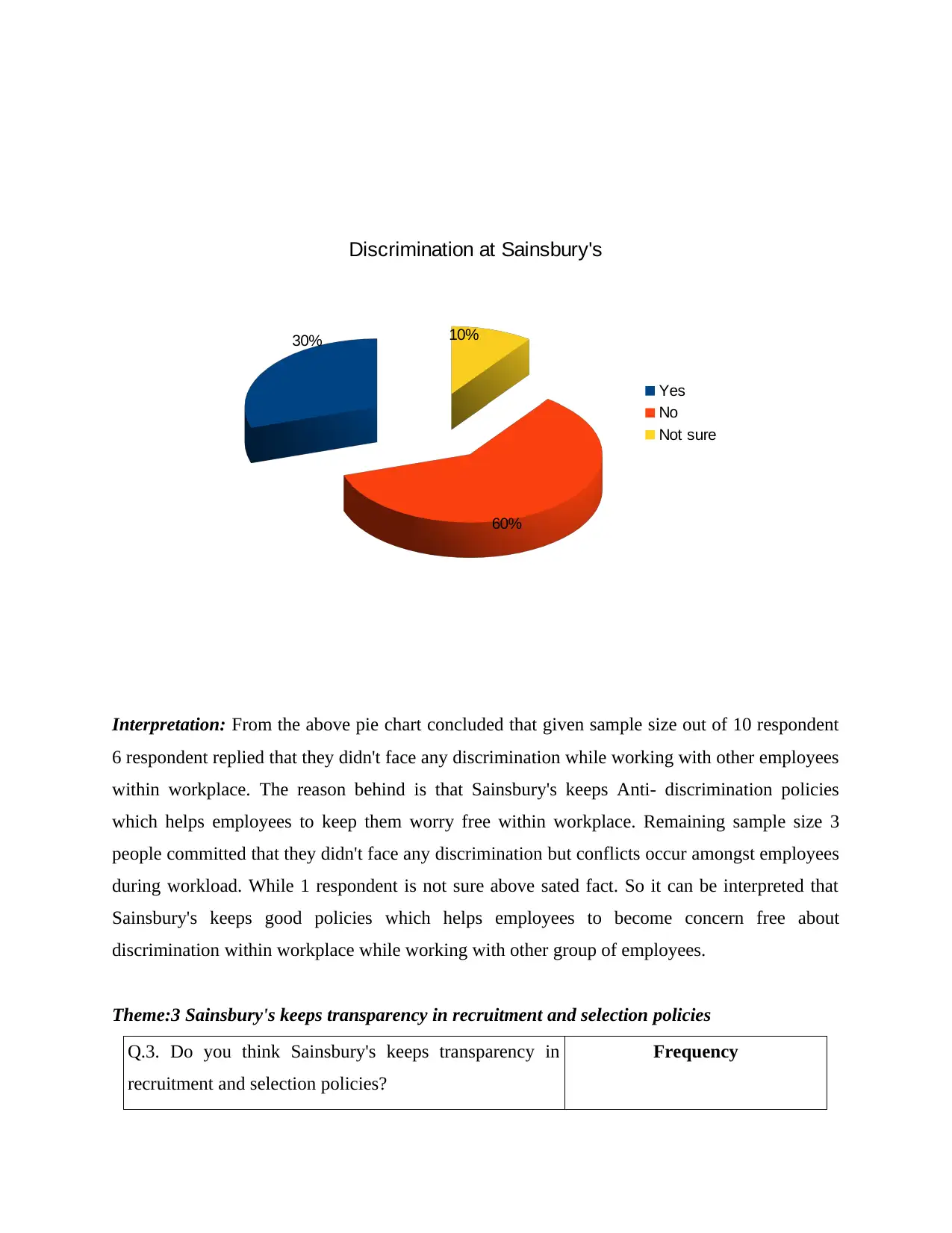
Interpretation: From the above pie chart concluded that given sample size out of 10 respondent
6 respondent replied that they didn't face any discrimination while working with other employees
within workplace. The reason behind is that Sainsbury's keeps Anti- discrimination policies
which helps employees to keep them worry free within workplace. Remaining sample size 3
people committed that they didn't face any discrimination but conflicts occur amongst employees
during workload. While 1 respondent is not sure above sated fact. So it can be interpreted that
Sainsbury's keeps good policies which helps employees to become concern free about
discrimination within workplace while working with other group of employees.
Theme:3 Sainsbury's keeps transparency in recruitment and selection policies
Q.3. Do you think Sainsbury's keeps transparency in
recruitment and selection policies?
Frequency
30%
60%
10%
Discrimination at Sainsbury's
Yes
No
Not sure
6 respondent replied that they didn't face any discrimination while working with other employees
within workplace. The reason behind is that Sainsbury's keeps Anti- discrimination policies
which helps employees to keep them worry free within workplace. Remaining sample size 3
people committed that they didn't face any discrimination but conflicts occur amongst employees
during workload. While 1 respondent is not sure above sated fact. So it can be interpreted that
Sainsbury's keeps good policies which helps employees to become concern free about
discrimination within workplace while working with other group of employees.
Theme:3 Sainsbury's keeps transparency in recruitment and selection policies
Q.3. Do you think Sainsbury's keeps transparency in
recruitment and selection policies?
Frequency
30%
60%
10%
Discrimination at Sainsbury's
Yes
No
Not sure
⊘ This is a preview!⊘
Do you want full access?
Subscribe today to unlock all pages.

Trusted by 1+ million students worldwide
1 out of 32
Related Documents
Your All-in-One AI-Powered Toolkit for Academic Success.
+13062052269
info@desklib.com
Available 24*7 on WhatsApp / Email
![[object Object]](/_next/static/media/star-bottom.7253800d.svg)
Unlock your academic potential
Copyright © 2020–2025 A2Z Services. All Rights Reserved. Developed and managed by ZUCOL.




